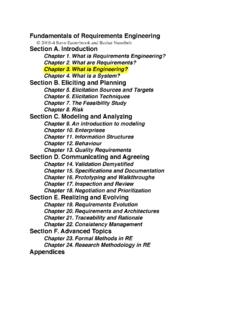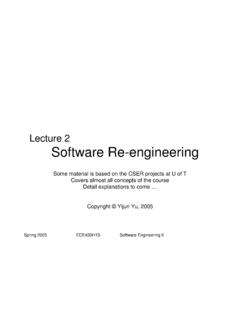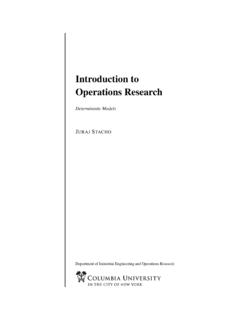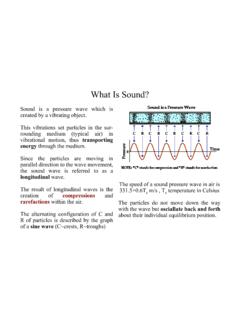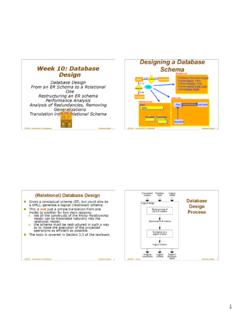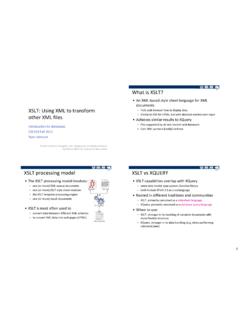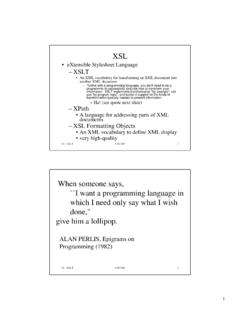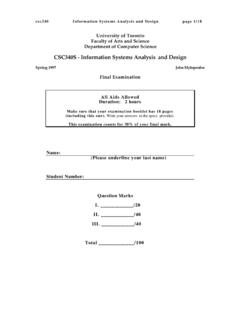Transcription of ImageNet Classification with Deep Convolutional Neural …
1 ImageNet Classification with Deep Convolutional Neural Networks Alex Krizhevsky Ilya Sutskever Geoffrey E. Hinton University of Toronto University of Toronto University of Toronto Abstract We trained a large, deep Convolutional Neural network to classify the million high-resolution images in the ImageNet LSVRC-2010 contest into the 1000 dif- ferent classes. On the test data, we achieved top-1 and top-5 error rates of and which is considerably better than the previous state-of-the-art. The Neural network, which has 60 million parameters and 650,000 neurons, consists of five Convolutional layers, some of which are followed by max-pooling layers, and three fully-connected layers with a final 1000-way softmax. To make train- ing faster, we used non-saturating neurons and a very efficient GPU implemen- tation of the convolution operation. To reduce overfitting in the fully-connected layers we employed a recently-developed regularization method called dropout.
2 That proved to be very effective. We also entered a variant of this model in the ILSVRC-2012 competition and achieved a winning top-5 test error rate of , compared to achieved by the second-best entry. 1 Introduction Current approaches to object recognition make essential use of machine learning methods. To im- prove their performance, we can collect larger datasets, learn more powerful models, and use bet- ter techniques for preventing overfitting. Until recently, datasets of labeled images were relatively small on the order of tens of thousands of images ( , NORB [16], Caltech-101/256 [8, 9], and CIFAR-10/100 [12]). Simple recognition tasks can be solved quite well with datasets of this size, especially if they are augmented with label-preserving transformations. For example, the current- best error rate on the MNIST digit-recognition task (< ) approaches human performance [4]. But objects in realistic settings exhibit considerable variability, so to learn to recognize them it is necessary to use much larger training sets.
3 And indeed, the shortcomings of small image datasets have been widely recognized ( , Pinto et al. [21]), but it has only recently become possible to col- lect labeled datasets with millions of images. The new larger datasets include LabelMe [23], which consists of hundreds of thousands of fully-segmented images, and ImageNet [6], which consists of over 15 million labeled high-resolution images in over 22,000 categories. To learn about thousands of objects from millions of images, we need a model with a large learning capacity. However, the immense complexity of the object recognition task means that this prob- lem cannot be specified even by a dataset as large as ImageNet , so our model should also have lots of prior knowledge to compensate for all the data we don't have. Convolutional Neural networks (CNNs) constitute one such class of models [16, 11, 13, 18, 15, 22, 26]. Their capacity can be con- trolled by varying their depth and breadth, and they also make strong and mostly correct assumptions about the nature of images (namely, stationarity of statistics and locality of pixel dependencies).
4 Thus, compared to standard feedforward Neural networks with similarly-sized layers, CNNs have much fewer connections and parameters and so they are easier to train, while their theoretically-best performance is likely to be only slightly worse. 1. Despite the attractive qualities of CNNs, and despite the relative efficiency of their local architecture, they have still been prohibitively expensive to apply in large scale to high-resolution images. Luck- ily, current GPUs, paired with a highly-optimized implementation of 2D convolution, are powerful enough to facilitate the training of interestingly-large CNNs, and recent datasets such as ImageNet contain enough labeled examples to train such models without severe overfitting. The specific contributions of this paper are as follows: we trained one of the largest Convolutional Neural networks to date on the subsets of ImageNet used in the ILSVRC-2010 and ILSVRC-2012. competitions [2] and achieved by far the best results ever reported on these datasets.
5 We wrote a highly-optimized GPU implementation of 2D convolution and all the other operations inherent in training Convolutional Neural networks, which we make available publicly1 . Our network contains a number of new and unusual features which improve its performance and reduce its training time, which are detailed in Section 3. The size of our network made overfitting a significant problem, even with million labeled training examples, so we used several effective techniques for preventing overfitting, which are described in Section 4. Our final network contains five Convolutional and three fully-connected layers, and this depth seems to be important: we found that removing any Convolutional layer (each of which contains no more than 1% of the model's parameters) resulted in inferior performance. In the end, the network's size is limited mainly by the amount of memory available on current GPUs and by the amount of training time that we are willing to tolerate.
6 Our network takes between five and six days to train on two GTX 580 3GB GPUs. All of our experiments suggest that our results can be improved simply by waiting for faster GPUs and bigger datasets to become available. 2 The Dataset ImageNet is a dataset of over 15 million labeled high-resolution images belonging to roughly 22,000. categories. The images were collected from the web and labeled by human labelers using Ama- zon's Mechanical Turk crowd-sourcing tool. Starting in 2010, as part of the Pascal Visual Object Challenge, an annual competition called the ImageNet Large-Scale Visual Recognition Challenge (ILSVRC) has been held. ILSVRC uses a subset of ImageNet with roughly 1000 images in each of 1000 categories. In all, there are roughly million training images, 50,000 validation images, and 150,000 testing images. ILSVRC-2010 is the only version of ILSVRC for which the test set labels are available, so this is the version on which we performed most of our experiments.
7 Since we also entered our model in the ILSVRC-2012 competition, in Section 6 we report our results on this version of the dataset as well, for which test set labels are unavailable. On ImageNet , it is customary to report two error rates: top-1 and top-5, where the top-5 error rate is the fraction of test images for which the correct label is not among the five labels considered most probable by the model. ImageNet consists of variable-resolution images, while our system requires a constant input dimen- sionality. Therefore, we down-sampled the images to a fixed resolution of 256 256. Given a rectangular image, we first rescaled the image such that the shorter side was of length 256, and then cropped out the central 256 256 patch from the resulting image. We did not pre-process the images in any other way, except for subtracting the mean activity over the training set from each pixel. So we trained our network on the (centered) raw RGB values of the pixels.
8 3 The Architecture The architecture of our network is summarized in Figure 2. It contains eight learned layers . five Convolutional and three fully-connected. Below, we describe some of the novel or unusual features of our network's architecture. Sections are sorted according to our estimation of their importance, with the most important first. 1. 2. ReLU Nonlinearity The standard way to model a neuron's output f as a function of its input x is with f (x) = tanh(x). or f (x) = (1 + e x ) 1 . In terms of training time with gradient descent, these saturating nonlinearities are much slower than the non-saturating nonlinearity f (x) = max(0, x). Following Nair and Hinton [20], we refer to neurons with this nonlinearity as Rectified Linear Units (ReLUs). Deep Convolutional Neural net- works with ReLUs train several times faster than their equivalents with tanh units. This is demonstrated in Figure 1, which shows the number of iterations re- quired to reach 25% training error on the CIFAR-10.
9 Dataset for a particular four-layer Convolutional net- work. This plot shows that we would not have been able to experiment with such large Neural networks for this work if we had used traditional saturating neuron Figure 1: A four-layer Convolutional Neural models. network with ReLUs (solid line) reaches a 25%. training error rate on CIFAR-10 six times faster We are not the first to consider alternatives to tradi- than an equivalent network with tanh neurons tional neuron models in CNNs. For example, Jarrett (dashed line). The learning rates for each net- et al. [11] claim that the nonlinearity f (x) = |tanh(x)|. work were chosen independently to make train- works particularly well with their type of contrast nor- ing as fast as possible. No regularization of malization followed by local average pooling on the any kind was employed. The magnitude of the Caltech-101 dataset. However, on this dataset the pri- effect demonstrated here varies with network mary concern is preventing overfitting, so the effect architecture, but networks with ReLUs consis- they are observing is different from the accelerated tently learn several times faster than equivalents ability to fit the training set which we report when us- with saturating neurons.
10 Ing ReLUs. Faster learning has a great influence on the performance of large models trained on large datasets. Training on Multiple GPUs A single GTX 580 GPU has only 3GB of memory, which limits the maximum size of the networks that can be trained on it. It turns out that million training examples are enough to train networks which are too big to fit on one GPU. Therefore we spread the net across two GPUs. Current GPUs are particularly well-suited to cross-GPU parallelization, as they are able to read from and write to one another's memory directly, without going through host machine memory. The parallelization scheme that we employ essentially puts half of the kernels (or neurons) on each GPU, with one additional trick: the GPUs communicate only in certain layers. This means that, for example, the kernels of layer 3 take input from all kernel maps in layer 2. However, kernels in layer 4 take input only from those kernel maps in layer 3 which reside on the same GPU.
